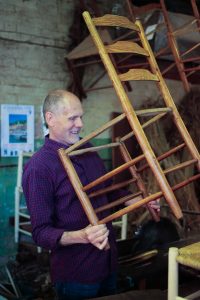 An amazing opportunity has come up for two people to learn from one of the country’s top traditional craftspeople and carry forward an important traditional craft.
An amazing opportunity has come up for two people to learn from one of the country’s top traditional craftspeople and carry forward an important traditional craft.
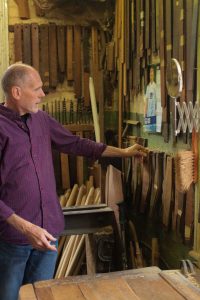 Lawrence Neal has spent his life making rush seated chairs, a trade he learned from his father Neville, who in turn learned from Edward Gardiner. Gardiner had learned from the famous architect and designer Ernest Gimson who had was taught by country chairmaker Philip Clissett. Lawrence is now approaching retirement and is looking to pass on his skills, knowledge and tools many of which were originally owned by Gimson.
Lawrence Neal has spent his life making rush seated chairs, a trade he learned from his father Neville, who in turn learned from Edward Gardiner. Gardiner had learned from the famous architect and designer Ernest Gimson who had was taught by country chairmaker Philip Clissett. Lawrence is now approaching retirement and is looking to pass on his skills, knowledge and tools many of which were originally owned by Gimson.
Heritage Crafts Association supporter Hugo Burge has taken a personal interest in Lawrence’s chairs and is going to fund the training process for Lawrence to pass his skills on. Not only that but once the successful new chairmakers are trained he can provide a workshop and subsidised accommodation on the Marchmont Estate in Scotland… all-in-all a once in a lifetime opportunity for the right person.
Hugo said:
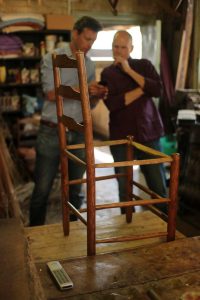 “I fell in love with the Ernest Gimson’s Bedales Library and its chairs over 20 years ago when I bought six Bedales chairs from Lawrence Neal in 1994. Much more recently, I have been working with Lawrence Neal, who continues to make rush seated chairs today in a 100 year tradition from Ernest Gimson, still using Gimson’s tools. We are now looking for two individuals to learn from Lawrence directly (as apprentices), in Stockton, Warwickshire for one to two years, before moving the whole workshop up to Marchmont House stables in Berwickshire to let Lawrence retire and take the business forwards within a charitable structure.
“I fell in love with the Ernest Gimson’s Bedales Library and its chairs over 20 years ago when I bought six Bedales chairs from Lawrence Neal in 1994. Much more recently, I have been working with Lawrence Neal, who continues to make rush seated chairs today in a 100 year tradition from Ernest Gimson, still using Gimson’s tools. We are now looking for two individuals to learn from Lawrence directly (as apprentices), in Stockton, Warwickshire for one to two years, before moving the whole workshop up to Marchmont House stables in Berwickshire to let Lawrence retire and take the business forwards within a charitable structure.
The business will generate a good living and offers the opportunity to grow and evolve, with an incredible lineage, using the actual tools of Ernest Gimson from Daneway – one of Britain’s greatest architect designers and pioneers of The Arts and Crafts Movement. There will be a base salary and the opportunity to grow your income, taking subsidised accommodation on the Marchmont Estate when you establish the workshop. This is a unique opportunity to build and create a new legacy; a new chapter of chairmaking – it will require commitment and long term dedication, so will be highly selective and not for everyone, but for two people with a real passion for taking the legacy of this traditional process into the twenty first century…..it will be ideal”
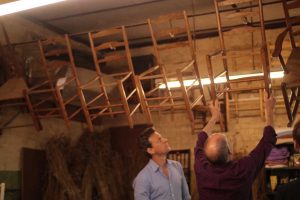 If you think this may suit you, download the application form here (deadline for applications 31 March 2018).
If you think this may suit you, download the application form here (deadline for applications 31 March 2018).
 It seems to me that the life many people aspire to at the moment involves spending the working day in important meetings or at a computer or doing similar cerebral work, then in the morning or evening jogging or pumping iron at the gym to get that perfect body.
It seems to me that the life many people aspire to at the moment involves spending the working day in important meetings or at a computer or doing similar cerebral work, then in the morning or evening jogging or pumping iron at the gym to get that perfect body.
These gyms seem bizarre places to me, I have walked past them in London full of folk pounding away like so many hamsters on wheels. The bizarre thing is that all those machines are consuming electricity, I’d like to see a gym that generated electricity or better see those folk out carrying shopping for old ladies or some other useful physical activity. Besides that I struggle with the idea of pounding away just to get the current trendy body shape. I think far better to live a balanced life that involves a mix of cerebral and physical activity. At the moment I am converting my ex village police station into a holiday cottage, there is a lot of hard labouring work which a hard nosed business annalist would say I should pay a labourer £50 a day to do whilst I got on with more lucrative work. I earn an average of £80 a day so I can’t argue with the economics but there is something more important than economics to me. By doing the labouring myself I get a feeling of empowerment, and also a good workout which would cost my cerebral friends a hefty gym fee. Here I am starting to demolish the old wall separating the old garage from the police station office, I reckon you could charge for this it was such fun.
Why is it that doing this stuff as part of the working day is looked down upon whilst paying to sweat in the gym is viewed as a good thing? This is all part of my philosophy of living a balanced life with work involving hand, head and heart.
HCA trustee Greta Bertram shares her first notes from Japan
I’ve been in Japan for 2 weeks now (with another 4 to go) and have already seen plenty of wonderful Japanese crafts. Although it is hot in August, I have to admit I`m a fan of hot weather so I’m having a great time. I’ve so far been to Yokohama, Tokyo, Nagoya (inlcuding Tokoname for pottery and Arimatsu for shibori `tie-dyeing`) and Kanazawa (gold leaf and kaga-yuzen dyeing). Tomorrow I`m off on a day trip to Wajima, famous for it`s lacquerware. The past few days have been a bit tricky, as many things have been closed for O-Bon – a bit national holiday for honouring the spirits of the ancestors.
Here’s a very brief introduction to some of the things I`ve seen so far. It`s amazing how widely exhibited crafts are, everywhere. I began my crafts exploration with a trip to the Japan Traditional Craft Centre in Ikebukuro, Tokyo. It`s essentially a salesroom/exhibition space – all the objects are exhibited beautifully, and all of them are for sale. I tried to make a list of every type of craft on display, but there were just too many to count and I had to give up! The temporary display changes every two weeks, and there was also space for a crafts-person-in-residence. Unfortunately, photos weren’t allowed.
Traditional Craft Industry is a status designated by the Ministry of Economy, Trade and Industry, and to be designated as such a craft must fulfill the following criteria.
- The article must be used mainly in everyday life.
- The article must be primarily manufactured by hand.
- The article must be manufactured using traditional techniques.
- The materials should be mainly those which have been traditionally employed.
- The industry must be of a regional nature.
Japan also has a traditional crafts mark which is administered by each local craft association according to the criteria set by the Ministry. According to the Centre, the mark `guarantees quality and authenticity and they are indeed the pride of the craftspeople`.
I found the 5th criteria really interesting. I would say that Japan has very strong regional identities, with crafts, theatre, food etc. being associated with different places. Every prefecture in Japan has a traditional crafts centre with an exhibition facility (as do many of the craft associations, and these often have resident craftspeople demonstrating their work to visitors). I found a map showing all of the crafts and where in Japan they come from, and the variety is incredible. Today I visited the Ishikawa Traditional Craft Centre in Kanazawa, which displays the 36 crafts of the region (including lacquerware, kutani ceramics, kaga-yuzen dyeing, butsdan-making (Buddhist altars), paper lanterns, umbrellas, candles, lion-masks and kaga-embroidery! Is there anything like this in the UK? I can`t think of anywhere, even in London…
Yuzen dyeing is a bit like batik – a resist is created using rice paste, the design is painted in with colour and then covered with another layer of rice paste before being dyed.]
[Photo Photo IMG_4603 and IMG_4602. Caption: Ishikawa Prefecture is famous for both its lacquerware and its gold leaf. The gold leaf is repeatedly pounded and pounded between sheets of special paper made from a plant that I’ve forgotten the name of until the gold is only 0.0001mm thick (I think). What`s interesting about these bowls is that they`re replicas of the top 100 lacquer bowls in Japan. I was amazed that there`s actually a list of the top bowls!]
Another place for displaying traditional crafts is in department stores. The big stores (like Takashimaya, Sogo, Mitsukoshi etc.) often have one floor dedicated to traditional Japanese products (porcelain, kimono, household goods etc.) and another floor which serves as a gallery space. I was lucky enough to visit the Sogo department store in Yokohama when they had several days of craftspeople from around the country demonstrating and selling their work.
A basketmaker at work in Sogo department store. These baskets are made out of Japanese Rose.
[Photo IMG_4423. Caption: Some of the prices were incredible – the little knife at the bottom was no more than about 5cm and costs about 150 pounds.]
While this obi costs about 5,600 pounds!]
Japanese `traditional` crafts are by no means stuck in the past – this technique was developed by the maker, and involves putting hundreds and hundreds of tiny pieces of opal onto the lacquer and sanding them down until smooth. The amazing thing was how the opal changed from red to green as you moved it in the light.
And it`s not only the techniques that are new – it`s the objects too, like this Iphone case!]
From what I’ve seen so far, traditional crafts really are much more a part of people`s lives in Japan then they are in the UK. Hope to be able to update again soon, with a few more photos.
 Well I never knew that Tonbridge was famous for the making of cricket balls. This is a craft process involving a lot of hand skill. I had little idea what was inside a cricket ball, a lump of compressed cork, a tightly wound ball of string.
Well I never knew that Tonbridge was famous for the making of cricket balls. This is a craft process involving a lot of hand skill. I had little idea what was inside a cricket ball, a lump of compressed cork, a tightly wound ball of string.
In the 1960’s there were 85 folk making balls in Tonbridge alone, but there was already mention of cheaper balls made in Pakistan and India, I love this 1960’s article from the Kent messenger especially the union reps title.
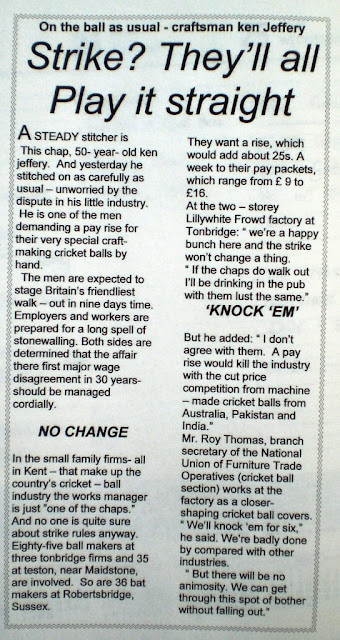 I am not sure how many ball manufacturers are left in Tonbridge. nor what proportion are hand stitched as against machine made but I do remember watching a guy from Alfred Reader’s stitching balls at Art in Action in 1996.
I am not sure how many ball manufacturers are left in Tonbridge. nor what proportion are hand stitched as against machine made but I do remember watching a guy from Alfred Reader’s stitching balls at Art in Action in 1996.
Reader’s are clearly still the major brand name in cricket balls I just called them to ask about how their balls were made and was told by a wonderfully frank and honest lady that they are all imported and only “finished” here. Bit naughty when they proudly bear the “Made in England” brand, years ago when I worked on a cutting table in Leicester lingerie firm I was told it was legal to put “Made in England” so long as some manufacturing process had taken place….and sewing in a “Made in England” label counted as a manufacturing process. The old Reader factory was sold off for housing development. The more I learn about how we treat our heritage the more I think it is bonkers. Just look at this travesty, clearly the powers that be decided what was important was to keep the factory frontage with it’s nice big sign, so they knocked it down and stuck a horrid modern house on the back. I have no doubt this makes great economic sense and was the way to make the most money out of the particular site.
 So we will be following up the glorious English game with the ECB and hoping that we don’t find the sort of story of child labour that was highlighted with footballs a few years ago. If anyone can find us info on any UK made cricket balls I would be pleased to hear and we will give the makers a good plug
So we will be following up the glorious English game with the ECB and hoping that we don’t find the sort of story of child labour that was highlighted with footballs a few years ago. If anyone can find us info on any UK made cricket balls I would be pleased to hear and we will give the makers a good plug
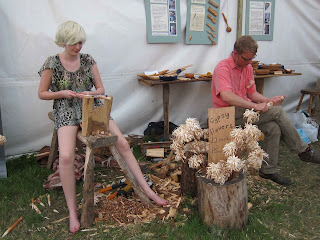 Last weekend I attended Art in Action a most wonderful show near Oxford. We were offered a free HCA stand after the organisers attended our spring conference at the V&A, we had the usual range of traditional craft items on display with voluntary staff telling visitors the stories behind how they were made. I also did a talk each day in the lecture rooms on the work of the HCA.
Last weekend I attended Art in Action a most wonderful show near Oxford. We were offered a free HCA stand after the organisers attended our spring conference at the V&A, we had the usual range of traditional craft items on display with voluntary staff telling visitors the stories behind how they were made. I also did a talk each day in the lecture rooms on the work of the HCA.
I was demonstrating spooncarving and daughter Jojo made everlasting gypsy flowers from willow.
 It is a huge show of primarily skill based arts and crafts, so much to see it takes a whole day. Sadly I was so busy on the stand I had little time to look around or take photos but here are a couple fo snaps taken en route for lunch. Gail McGarva with her wonderful Lyme Lerret.
It is a huge show of primarily skill based arts and crafts, so much to see it takes a whole day. Sadly I was so busy on the stand I had little time to look around or take photos but here are a couple fo snaps taken en route for lunch. Gail McGarva with her wonderful Lyme Lerret.
An incredibly detailed carving of a mallard drake. This one is worth clicking to expand the image.
 One of the beauties of Art in Action is that most of the artists and craftspeople are given space to set up a workshop and demonstrate their work. You can see anything from artists painting proper portraits, grinding their own pigments to weaving, glassblowing and blacksmithing, the quality is all excellent.
One of the beauties of Art in Action is that most of the artists and craftspeople are given space to set up a workshop and demonstrate their work. You can see anything from artists painting proper portraits, grinding their own pigments to weaving, glassblowing and blacksmithing, the quality is all excellent.
 The ethos of the event is lovely too. It centres around giving and service, the volunteers that run the event are kind and helpful and I know no other event where all the stand holders are continually supplied with tea and biscuits served with a smile. This is the campsite with the poshest portaloos and showers I have seen.
The ethos of the event is lovely too. It centres around giving and service, the volunteers that run the event are kind and helpful and I know no other event where all the stand holders are continually supplied with tea and biscuits served with a smile. This is the campsite with the poshest portaloos and showers I have seen.
We hope to be invited again next year and will ask for space for more traditional craft demonstrators.
 An amazing opportunity has come up for two people to learn from one of the country’s top traditional craftspeople and carry forward an important traditional craft.
An amazing opportunity has come up for two people to learn from one of the country’s top traditional craftspeople and carry forward an important traditional craft. Lawrence Neal has spent his life making rush seated chairs, a trade he learned from his father Neville, who in turn learned from Edward Gardiner. Gardiner had learned from the famous architect and designer Ernest Gimson who had was taught by country chairmaker Philip Clissett. Lawrence is now approaching retirement and is looking to pass on his skills, knowledge and tools many of which were originally owned by Gimson.
Lawrence Neal has spent his life making rush seated chairs, a trade he learned from his father Neville, who in turn learned from Edward Gardiner. Gardiner had learned from the famous architect and designer Ernest Gimson who had was taught by country chairmaker Philip Clissett. Lawrence is now approaching retirement and is looking to pass on his skills, knowledge and tools many of which were originally owned by Gimson.“I fell in love with the Ernest Gimson’s Bedales Library and its chairs over 20 years ago when I bought six Bedales chairs from Lawrence Neal in 1994. Much more recently, I have been working with Lawrence Neal, who continues to make rush seated chairs today in a 100 year tradition from Ernest Gimson, still using Gimson’s tools. We are now looking for two individuals to learn from Lawrence directly (as apprentices), in Stockton, Warwickshire for one to two years, before moving the whole workshop up to Marchmont House stables in Berwickshire to let Lawrence retire and take the business forwards within a charitable structure.
 If you think this may suit you, download the application form here (deadline for applications 31 March 2018).
If you think this may suit you, download the application form here (deadline for applications 31 March 2018).

















